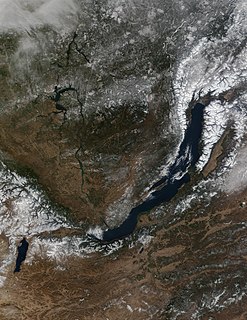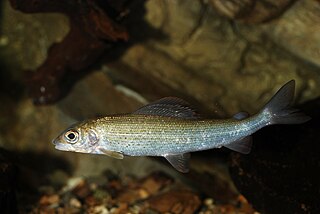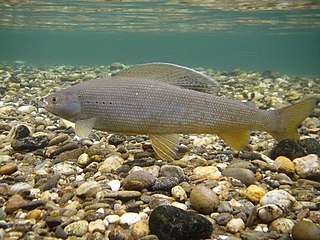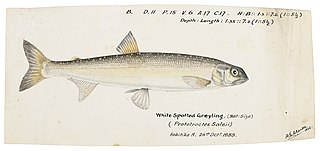
Thyme is the herb of some members of the genus Thymus of aromatic perennial evergreen herbs in the mint family Lamiaceae. Thymes are relatives of the oregano genus Origanum. They have culinary, medicinal, and ornamental uses, and the species most commonly cultivated and used for culinary purposes is Thymus vulgaris.

Salmonidae is a family of ray-finned fish, the only living family currently placed in the order Salmoniformes. It includes salmon, trout, chars, freshwater whitefishes, and graylings, which collectively are known as the salmonids. The Atlantic salmon and trout of the genus Salmo gives the family and order their names.

Lake Baikal is a rift lake located in Russia. It is situated in southern Siberia, between the federal subjects of Irkutsk Oblast to the northwest and the Buryatia to the southeast. Lake Baikal is the world's largest freshwater lake by volume, containing 22 to 23% of the world's fresh surface water. It contains 23,615.39 km3 (5,670 cu mi) of fresh water, which is more water than all of the North American Great Lakes combined. Lake Baikal has a maximum depth of 1,642 m (5,387 ft), and is the world's deepest lake. It is among the world's clearest lakes and is the world's oldest lake, at 25–30 million years. Lake Baikal is also the world's seventh-largest lake by surface area.

Coregonus lavaretus is a species of freshwater whitefish, in the family Salmonidae. It is the type species of its genus Coregonus.

Thymallus is a genus of freshwater fish in the salmon family Salmonidae; it is the only genus of subfamily Thymallinae. The type species is Thymallus thymallus, the grayling. The species in the genus are generically called graylings, but without qualification this also refers specifically to T. thymallus.

Thymallus thymallus, the grayling or European grayling, is a species of freshwater fish in the salmon family Salmonidae. It is the only species of the genus Thymallus native to Europe, where it is widespread from the United Kingdom and France to the Ural Mountains in Russia, but does not occur in the southern parts of the continent. It was introduced to Morocco in 1948, but it does not appear to have become established there.

The Allier is a river in central France. It is a left tributary of the Loire. Its source is in the Massif Central, in the Lozère department, east of Mende. It flows generally north. It joins the Loire west of the city of Nevers. It is 421 km (262 mi) long, and has a drainage basin of 14,350 km2 (5,540 sq mi).

The Arctic grayling is a species of freshwater fish in the salmon family Salmonidae. T. arcticus is widespread throughout the Arctic and Pacific drainages in Canada, Alaska, and Siberia, as well as the upper Missouri River drainage in Montana. In the U.S. state of Arizona, an introduced population is found in the Lee Valley and other lakes in the White Mountains. They were also stocked at Toppings Lake by the Teton Range and in lakes in the high Uinta Mountains in Utah, as well as alpine lakes of the Boulder Mountains (Idaho) in central Idaho.
Thymallus yaluensis is a putative species of freshwater fish, a grayling in the salmon family Salmonidae. It is endemic to the upper Yalu River in Korea, on the Chinese border.

Chalk streams are rivers that rise from springs in landscapes with chalk bedrock. Since chalk is permeable, water percolates easily through the ground to the water table and chalk streams therefore receive little surface runoff. As a result, the water in the streams contains little organic matter and sediment and is generally very clear. The beds of the rivers are generally composed of clean, compacted gravel and flints, which are good spawning areas for Salmonidae fish species.

The New Zealand grayling is an extinct species of fish which was endemic to New Zealand. The New Zealand grayling, was known by the Māori people by many names including pokororo, paneroro, kanae-kura, however, the most common being Upokororo. The variety of names for the fish came from either other tribes or to describe the fish at different periods of its life cycle. Even though this fish is named grayling, it is not related to European or American graylings and lacks the large dorsal fin ‘typical’ graylings are characterised by, however, is closely related to the Australian grayling. The New Zealand grayling was an amphidromous species, migrating between freshwater and saltwater during different seasons as well as stages in their life cycle. The species was abundant during the 19th century, however, the population decreased during the early 1900s with the last known sighting of the fish in 1923.

The houting is a European, allegedly extinct species of whitefish in the family Salmonidae. It is native to the estuaries and rivers draining to the North Sea. The houting is distinguishable from other Coregonus taxa by having a long, pointed snout, an inferior mouth and a different number of gill rakers. The houting once occurred in Belgium, France, Germany, the Netherlands and England.

Salmo dentex is a variety of trout, a freshwater fish in the family Salmonidae, found in the western Balkans. Until recently the identity, biological distinctness and species status of the dentex trout were not properly clarified, but genetic data now suggest it is not a monophyletic unit that could be distinguished from other salmonids as a separate species.

Lenoks are a genus, Brachymystax, of salmonid fishes native to rivers and lakes in Mongolia, Kazakhstan, wider Siberia (Russia), Northern China, and Korea.

Brachymystax lenok, the sharp-snouted lenok, is a salmonid fish distributed in rivers and lakes in northeastern Asia. It formerly included the blunt-snouted lenok, but recent authorities typically treat the latter as a separate species, B. tumensis, based on differences in morphology and genetics.

The Loire is the longest river in France and the 171st longest in the world. With a length of 1,006 kilometres (625 mi), it drains 117,054 km2 (45,195 sq mi), more than a fifth of France's land while its average discharge is only half that of the Rhône.

The Montana Arctic grayling is a North American freshwater fish in the salmon family Salmonidae. The Montana Arctic grayling, native to the upper Missouri River basin in Montana and Wyoming, is a disjunct population or subspecies of the more widespread Arctic grayling. It occurs in fluvial and adfluvial, lacustrine forms. The Montana grayling is a species of special concern in Montana and had candidate status for listing under the national Endangered Species Act. It underwent a comprehensive status review by the U.S. Fish and Wildlife Service, which in 2014 decided not to list it as threatened or endangered. Current surviving native populations in the Big Hole River and Red Rock River drainages represent approximately four percent of the subspecies' historical range.

Brachymystax tumensis, the blunt-snouted lenok, is a salmonid fish distributed in rivers and lakes in Eastern Asia. It was formerly included in the more widespread species Brachymystax lenok, but more recent research based on differences in morphology and genetics have justified a distinction of the two species.

Thymallus baicalensis, also known as the Baikal black grayling, is a Siberian freshwater fish species in the salmon family Salmonidae.
















